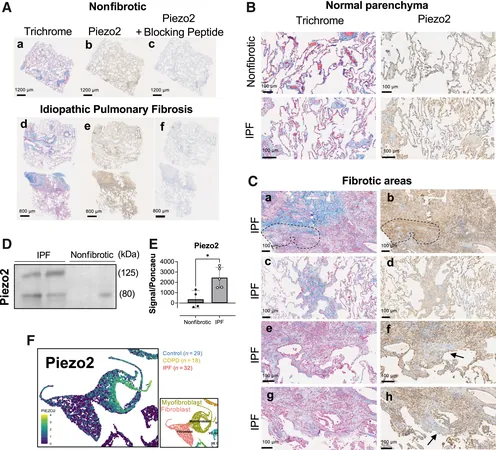
Breakthrough Discovery: New Pathway Could Halt the Advance of Pulmonary Fibrosis!
2025-03-25
Author: Daniel
Introduction
In an exciting new study, researchers have uncovered a promising approach that could slow the progression of pulmonary fibrosis, a debilitating lung disease, by targeting a specific receptor known as Piezo2. This novel pathway offers hope not only for pulmonary fibrosis but also for other fibrotic diseases that presently have limited treatment options.
Understanding Pulmonary Fibrosis
Pulmonary fibrosis, particularly idiopathic pulmonary fibrosis (IPF), is a progressive lung disease characterized by scarring of lung tissue, which ultimately leads to severe breathing difficulties. Unfortunately, the median survival after diagnosis is only 2.9 years, highlighting the urgent need for effective therapeutic strategies.
Research Focus on Piezo2
The study, published in *The American Journal of Pathology*, explores how Piezo2, a receptor that responds to mechanical forces such as stress and stiffness in tissues, plays a crucial role in the development of lung fibrosis. Researchers were motivated to investigate this connection due to exciting developments in the field, such as the award of the 2021 Nobel Prize in Medicine for the discovery of Piezo channels by Dr. Ardem Patapoutian.
Research Findings
Utilizing a variety of methods, including patient donor lung tissue analysis, mouse models of lung fibrosis, and cell culture studies, the team examined the expression and functions of Piezo2 in the context of pulmonary fibrosis. Their findings revealed that:
- Piezo2 is significantly overexpressed in the lung tissues of IPF patients, as well as in various mouse models of lung fibrosis.
- Lung fibroblasts, responsible for the fibrotic process, exhibit heightened Piezo2 expression when cultured, making them more likely to contribute to fibrosis.
- Fibroblasts grown on stiffer substrates, simulating the increased stiffness seen in fibrotic tissue, become more profibrotic, proliferating and generating excess matrix proteins.
- Inhibiting Piezo2 using RNA silencing or a peptide inhibitor effectively reduces the profibrotic programming of these cells.
Expert Insights
Lead researcher Dr. Patricia J. Sime from Virginia Commonwealth University expressed enthusiasm about these findings, stating, “Our research suggests that targeting Piezo2 could open new avenues for therapy in lung fibrosis and other fibrotic conditions. With many existing therapies falling short, this discovery could prove vital in addressing the unmet medical needs in this area.”
Currently available therapies like nintedanib and pirfenidone have provided some benefits but often fall short in halting disease progression entirely. The multifaceted nature of lung fibrosis, driven by numerous overlapping pathways, complicates treatment approaches.
Dr. Margaret A.T. Freeberg, the first author of the study, highlighted the challenges that persist with treating IPF and others forms of lung fibrosis. She stated, “Blocking Piezo2 signaling to reprogram fibroblasts represents a new strategy that can be utilized in our fight against fibrosis.”
Conclusion and Future Directions
Dr. Sime further emphasized the significance of their findings, noting that by understanding the influence of mechanical forces on lung cells and targeting Piezo2, a window of opportunity is created for potentially revolutionizing the treatment landscape for pulmonary fibrosis. Furthermore, the potential of new investigational drugs specifically targeting this receptor has received orphan drug designation from the FDA, which could expedite clinical development and attract pharmaceutical interest.
As the research progresses, the hope is that this breakthrough can lead to more effective treatments, improving lives and outcomes for patients grappling with these challenging diseases. Stay tuned as we follow further developments in this promising area of medical research!


 Brasil (PT)
Brasil (PT)
 Canada (EN)
Canada (EN)
 Chile (ES)
Chile (ES)
 Česko (CS)
Česko (CS)
 대한민국 (KO)
대한민국 (KO)
 España (ES)
España (ES)
 France (FR)
France (FR)
 Hong Kong (EN)
Hong Kong (EN)
 Italia (IT)
Italia (IT)
 日本 (JA)
日本 (JA)
 Magyarország (HU)
Magyarország (HU)
 Norge (NO)
Norge (NO)
 Polska (PL)
Polska (PL)
 Schweiz (DE)
Schweiz (DE)
 Singapore (EN)
Singapore (EN)
 Sverige (SV)
Sverige (SV)
 Suomi (FI)
Suomi (FI)
 Türkiye (TR)
Türkiye (TR)
 الإمارات العربية المتحدة (AR)
الإمارات العربية المتحدة (AR)